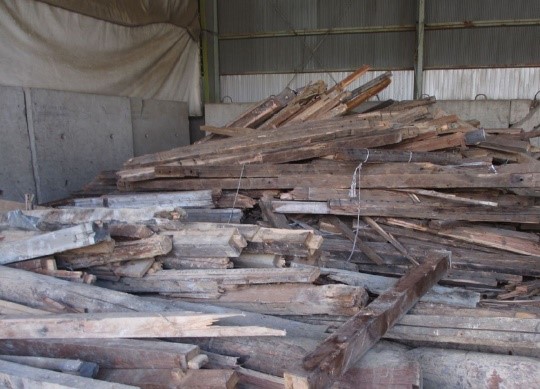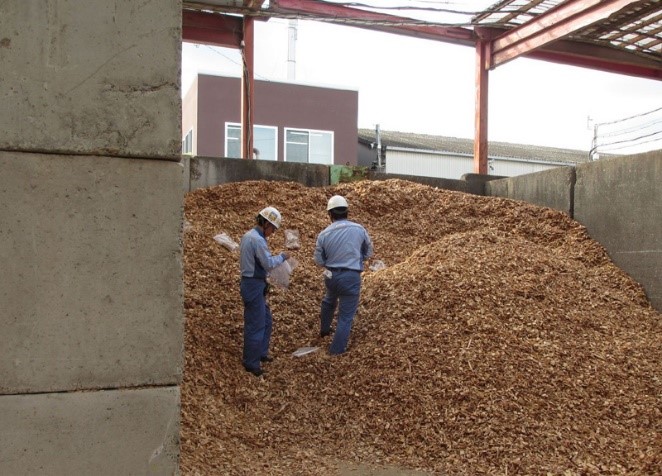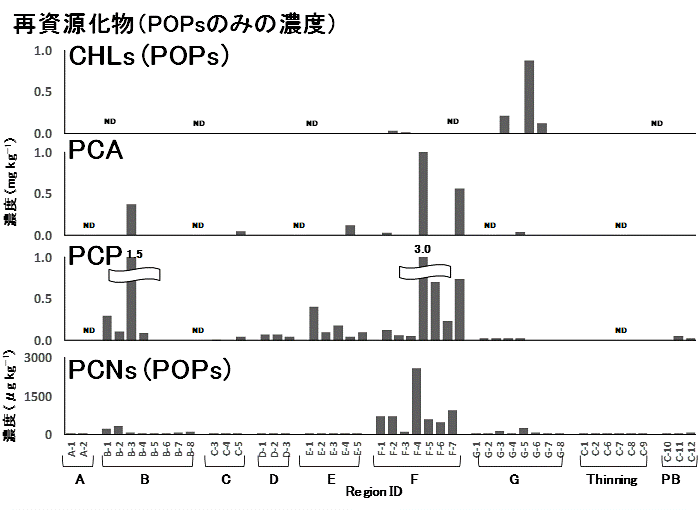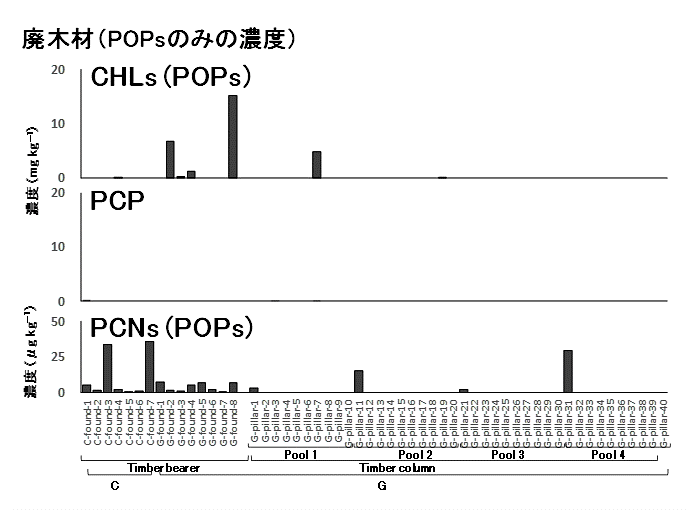- Waste management in Japan
- Circular economy in Japan
- Waste management in Asia
- Disaster waste management
Persistent Organic Pollutants (POPs) Contained in Construction and Demolition Waste Wood
English translation: March 2023
Recycling of construction and demolition waste wood and POPs
In this article, I will introduce recycling of construction and demolition (C&D) waste wood in Japan with a focus on Persistent Organic Pollutants (POPs) [1] that it contains. Japan has been proud of beautiful forests, and many buildings in the country have been made of wood. The oldest wooden building in Japan is said to be about 1,300-year-old Horyuji temple. However, in Japan’s hot and humid climate, termites and wood-rotting fungi can deteriorate wooden buildings, especially timber bearers, unless appropriate measures are taken against them. Therefore, it has been common for a long time to apply insecticides (e.g., anti-termite agents) and anti-septic agents to wooden materials. I remember seeing TV commercials of termite control companies frequently when I was young. At that time, copper-chrome-arsenate (CCA) preservatives and pentachlorophenol (PCP) were typically used as anti-septic agents, and polychloronaphthalenes (PCNs) as well as chlordane and related compounds (CHLs) were used as anti-termite agents. Since all these agents were highly harmful to human health and environment, they have now been replaced by less harmful ones. However, as PCP, PCNs, CHLs are all POPs, they do not easily degrade. Some of them can still be found in old wooden materials to which anti-termite and anti-septic agents were applied in the past.
Do you know what will happen to wooden buildings and utility poles (though we do not often see the latter nowadays) when they are demolished? Japan’s Construction Material Recycling Act obliges C&D contractors to recycle the waste wood they generate. According to a survey conducted in 2018 by the Ministry of Land, Infrastructure, Transport and Tourism, the recycling rate of C&D waste wood was 91.7%. This means that most of the C&D waste wood was recycled and utilized as a resource[2]. Another 2018 study by the Ministry of Agriculture, Forestry and Fisheries showed that 1.02 million tonnes of C&D waste wood (17.9% of the total raw materials for wood chip production) were used to produce wood chips (i.e., raw materials for paper pulp, laminated wood and biomass fuels)[3]. If C&D waste wood containing POPs contaminates raw materials for wood chip production, it can further contaminate recycled paper products and furniture and interior furnishings that are made of laminated wood. To control the C&D waste wood containing POPs, the Basel Convention stipulates that those with the concentrations of POPs exceeding respective internationally recognized threshold values (i.e., low POP content: LPC) must not be recycled but be disposed of through proper means (e.g., high-temperature incineration). The LPC values for PCNs, CHLs, PCP are 10 mg/kg (milligram per one kilogram of waste), 50 mg/kg, and 100 mg/kg, respectively.
Considering this background, our research team conducted a survey on the POP concentrations in C&D waste wood and wood chips.
POP concentrations in C&D waste wood
We collected a total of 42 wood chip samples from 7 C&D waste wood recycling facilities in Japan during the period from 2016 to 2017 (Photo 1 and 2). Of these, 38 samples were made of C&D waste wood, and 4 samples were made of green wood. In addition to these samples, we purchased 3 particleboard samples and collected 7 timber bearer samples from demolition waste in the Kanto region. In the Kyushu region, we further collected 8 timber bearer and 40 timber column samples from demolition waste. Then, we analyzed their PCN content at our institute (i.e., the National Institute for Environmental Studies), and also analyzed the concentrations of other POPs including CHLs, PCP, and pentachloroanisole (PCA) that is methyl ester of PCP, at Saga University.
 Photo 1. C&D waste wood in a recycling facility
Photo 1. C&D waste wood in a recycling facility Photo 2. Sampling of wood chips
Photo 2. Sampling of wood chipsThe highest POP concentrations detected among recycled wood products such as wood chips and particleboards were 0.86 mg/kg for CHLs, 3.0 mg/kg for PCP, 1.1 mg/kg for PCAs, and 2.6 mg/kg for PCNs (Fig. 1) respectively. As the detected value for PCNs was about one fourth of the LPC value (the lowest among these POPs), it was highly unlikely that POP concentrations of the recycled wood products exceeded their LPC values. We also examined relationships between raw materials for wood chips and POP concentrations and found that those made of C&D waste wood clearly showed higher POP concentrations than those made of green wood (i.e., those labeled as “Thinning” in Fig. 1). These results indicated that POP concentrations of wood chips were high if they were contaminated by C&D waste wood containing POPs. We also noted that wood chip samples from some specific facilities (i.e., those labeled as “F” and “G” in Fig. 1) showed higher POP concentrations than others.
We also measured the POP concentrations in C&D waste wood (i.e., timber bearers and columns). The highest POP concentrations detected were as follows: 15 mg/kg for CHLs, 0.20 mg/kg for PCP, 0.043 mg/kg for PCAs, and 0.036 mg/kg for PCNs (Fig. 2). They were much lower than their LPC values except for those for some CHLs. Before the survey, we had also expected high POP concentrations in the C&D waste wood as the wood chips produced from them had shown high POP concentrations. However, the detected values for the waste wood were not so high as we had expected. We consider that it was because the POPs in the anti-septic and anti-termite agents had been decomposed in the environment over a long time or eluted out by rainfalls.


Conclusion
As mentioned above, POPs exceeding the LPC values were not detected in any of the recycled wood products (wood chips and particle boards). As far as the POPs that were used as anti-septic or anti-termite agents are concerned, these results suggest that the existence of POPs in C&D waste wood is not a bottleneck for its recycling (“material recycling”) to produce raw materials for paper pulp and wood products. However, there are possibilities that the other anti-septic or anti-termite agents such as CCA preservatives may remain in C&D waste wood. Further investigation and verification are required on this point.
References
- [1] The Stockholm Convention on Persistent Organic Pollutants website
http://www.pops.int - [2] Ministry of Land, Infrastructure, Transport and Tourism of Japan, 2018 survey on the state of construction byproducts. (in Japanese)
https://www.mlit.go.jp/sogoseisaku/region/recycle/d02status/d0201/page_020101census.htm (Accessed on 25 September 2020) - [3] Ministry of Agriculture, Forestry and Fisheries of Japan, Statistics Survey on Lumber. (in Japanese)
https://www.maff.go.jp/j/tokei/kouhyou/mokuzai/ (Accessed on 25 September 2020)
For more information
- Koyano S., Ueno D., Yamamoto T., Kajiwara N. (2018) Concentrations of POPs based wood preservatives in waste timber from demolished buildings and its recycled products in Japan. Waste Management, 85, 445 - 451
- Kajiwara N (2019) Study on the environmentally sound management of wastes containing newly listed POPs (3K163005). Research accomplishment report for the Environment Research and Technology Development Fund (in Japanese)


